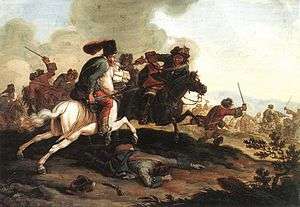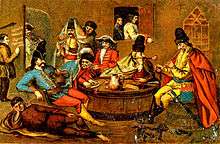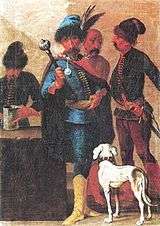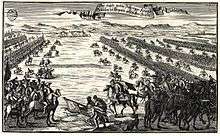Kuruc
The kuruc (Hungarian: [ˈkurut͡s], plural kurucok), also spelled kurutz,[1][2][3] were the armed anti-Habsburg rebels in Royal Hungary between 1671 and 1711.

The kuruc army was mostly made up of serfs, including Hungarian Protestant peasants,[4] but also many Slavs.[5]
Name
According to Matthias Bel, an 18th-century scholar, the word was first used in 1514 for the armed peasants led by György Dózsa. Bel supposed that the word kuruc is derived from the Latin word "cruciatus" (crusader), ultimately from "crux" (cross); and Dózsa's followers were called "crusaders" because the peasant rebellion started as an official crusade against the Ottomans.

Today's etymologists do not accept Bel's theory and consider the word, emerging in the 1660s in the forms "kurus", "kuroc" or "kurudsch", to be of unknown origin. Its original meaning was understood as rebel, partisan or dissident.[6]
In 1671, the name was used by Meni, the beglerbeg pasha of Eger in what is today Hungary, to denote the predominantly-noble refugees from Royal Hungary. Afterwards, the name became quickly popular and was used from 1671 to 1711 in texts written in Hungarian, Slovak and Turkish to denote the rebels of Royal Hungary and northern Transylvania, fighting against the Habsburgs and their policies.
The rebels of the first kuruc uprising called themselves bújdosók (fugitives) or in the official long form: "different fugitive orders—barons, nobles, cavalry and infantry soldiers—who fight for the material and spiritual liberty of the Hungarian motherland".
The leader of the last of the kuruc rebellions, Francis II Rákóczi, also did not use the term. Contemporary sources often used the term "malcontents" to denote the rebels.
The opposite term (widespread after 1678) was "labanc" (from the Hungarian word "lobonc", literally "long hair", referring to the wig worn by the Austrian soldiers), denoting Austrians and their loyalist supporters.
According to the chronicle of Silahdar Fındıklılı Mehmed Ağa, a 17th-century Ottoman chronicler, the word Kuruc ("Kurs" as it was transliterated into Ottoman Turkish in the chronicle) was a Greek word that meant "polished," or "cilâlı" in Turkish.[7]
History
The first kuruc uprising
The first kuruc uprising occurred in 1672. The kuruc army gathered in the Partium where many refugees of different origins took shelter from the religious and political persecution occurring in Royal Hungary. They called themselves bújdosók (fugitives). Their weapons were mostly pistols, light sabres and fokos (battle-axes).
Their tactics and style of war were typical of light cavalry. The main subgroups were Protestants, who were disgruntled by Habsburg ambitions of the Counter-Reformation; nobles (from the minor nobility, holding on to their privileges, while the Habsburg Court made attempts to deprive impoverished nobles of their nobility) and soldiers from the végvárs (frontier castles) who were sacked by Habsburg generals. Later, when the Turks lost ground to the imperial armies and Austrian despotism intensified, Habsburg oppression of Hungarians played an increasingly important role in the motivation of the kuruc.
Initially, in August 1672 the kuruc army invaded Upper Hungary where they conquered the castles of Diósgyőr, Ónod, Szendrő and Tokaj. After they defeated the Habsburg army of Paris von Spankau near Kassa the towns of Upper Hungary surrendered and many disaffected people joined them from the Slovak and Ruthenian population of the northern counties.
The two leaders of the army of "fugitives" were Pál Szepesi and Mátyás Szuhay, members of the minor nobility who previously took part in other anti-Habsburg movements.
According to the recollections of Pál Szepesi the "fugitives" began looting in the northern countries: "In the guise of persecuting the Papists they pillaged whole counties. We began killing the plunderers but to no avail—they didn't respect any officers."
The Hofkriegsrat of Vienna immediately took some measures: strengthened the Habsburg troops, called more soldiers from Lower Hungary and made peace with the Hajduks. On 26 October 1672 the Habsburg army defeated the "fugitives" at Gyurke (later Hungarian Györke, Slovak Ďurkov). The rebels retreated across the line of the Tisza.
After this initial success the Habsburg government began systematic religious and political persecution in Royal Hungary. The most infamous case was the trial of 300 Protestant pastors who were sentenced to death in 1674, and who later were sold as galley slaves in Naples, causing public outcry all over Europe.
Universitas of the "Fugitives"
In 1675 the "Fugitives" occupied Debrecen. Later in that year the town was sacked again by three different armies as was not uncommon that time in troubled Upper Hungary.
The fugitives tried to organise themselves as an independent community called "universitas" or "communitas". They issued decrees, sent envoys to foreign powers, made a seal and held Diets (assemblies). That time they were already called kuruc although they never called themselves so. Between 1674 and 1678 their leader was Count Paul Wesselényi, the cousin of the late Palatine Ferenc Wesselényi.
The "fugitives" established diplomatic connections with Poland in 1674 and France in 1675. In May 1677 France, Poland, the Principality of Transylvania and the universitas of the "Fugitives" signed a treaty in Warsaw, by which King Louis XIV of France guaranteed 100,000 tallers aid and assistance. The "Fugitives" were obliged to attack the Habsburgs with an army of at least 15,000 men. Michael I Apafi, the Prince of Transylvania, gave military and financial support to the universitas.
In the autumn of 1677 2,000 French, Polish and Tatar soldiers arrived in Upper Hungary. This small army, led by colonel Beaumont, wasn't able to seriously threaten Habsburg supremacy. Royal Hungary became one theatre of the European war between Emperor Leopold I and Louis XIV. The president of the Viennese Hofkriegsrat, Raimondo Montecuccoli draw a plan of "pacification" under the title "L'Ungheria nell'anno 1677". According to that Royal Hungary would be occupied by three Austrian armies, the remnants of the Hungarian constitution abolished and a grand-scale program of German colonisation implemented. Chancellor Paul Hocher, one of the most influential man in the Habsburg government, agreed with Montecuccoli's plan. In the Privy Council he declared that "all Hungarians are traitors".
Under Mihály Teleki
In 1678 the fugitives accepted Mihály Teleki, the Chancellor of Transylvania as their leader. Prince Apafi proclaimed war against the Habsburgs. Before that he had to beg leave the Ottoman Sultan (his overlord). The Sultan demanded an unacceptable condition: in the case of success all Royal Hungary should become part of the Ottoman Empire.

On 5 April 1678 Prince Apafi issued an ambiguous declaration to the people of Hungary: he announced that himself together with the Polish and the French kings took up the arms against "the heavy yoke of oppression" and recommended "the submission to the mighty Turkish Emperor with a reasonable mind and sharp eye".
The kuruc army of Teleki together with the Polish and French troops advanced well into Upper Hungary but they immediately retreated into Transylvania at the sight of the first Habsburg regiments. The failure wrecked Teleki's image as a competent leader. On the other hand, a small kuruc cavalry troop (with only 8000 people) occupied for a short time the most important mining towns and castles of Lower Hungary.
The great kuruc uprisings
In 1678 one of the most influential young nobleman of Upper Hungary and Transylvania, Imre Thököly declared war against the Habsburgs. In August 1678 Thököly's army occupied almost all Lower and Upper Hungary. Habsburg rule in Royal Hungary quickly collapsed. The fugitives joined the Thököly Uprising, and officially elected him their leader in Szoboszló in January 1680. The kuruc troops were merged into Thököly's own army.
That time onwards the history of the kurucs are synonymous with the history of the two great anti-Habsburg uprisings in the Kingdom of Hungary between 1680 and 1711, i.e. the Thököly Uprising and the Rákóczi Uprising. Although these movements are generally called kuruc wars, these anti-Habsburg uprisings had a much wider social base and more complex political aims than the original kuruc movements. See the history of the great kuruc uprisings under their respective leaders, Imre Thököly and Francis II Rákóczi.
Later usage

In the first half of the 18th century the term was generally used to denote Hungarian cavalry soldiers (Hussars) serving in the Habsburg army, especially in the time of the War of the Austrian Succession (1740–1748). Many former kuruc soldiers of the Rákóczi Uprising joined the Habsburg army after 1711.
The Prussians were also called kurucs in Hungarian literature, for example by Joseph Gvadányi in 1790. The reason behind this strange usage was that all the enemies of the labanc Habsburgs were considered synonymous with the kurucs.
In the end of the 18th century the word went out of usage in common parlance, and became an exclusively historical term for the rebels of Rákóczi and Thököly.
In present-day South German language Kruzitürken is a swear word, combining Kuruzen (Kuruc) and Türken (Turks), with the meaning of "curse it".
In present-day Hungarian language kuruc is sometimes used to denote Hungarian national radicals. "Kuruc.info" is also a name of a far-right, nationalist Hungarian webpage.[8]
References
- Schreiber, Thomas. 1974. Hungary. Geneva: Nagel, p. 45.
- Castellan, Georges. 1992. History of the Balkans: From Mohammed the Conqueror to Stalin. Boulder, CO: East European Monographs, pp. 170 ff.
- Dávid, Géza. 1997. Studies in demographic and administrative history of Ottoman Hungary. Istanbul: Isis Press, pp. 226 ff.
- Sándor Bonkáló, The Rusyns, Carpatho-Rusyn Research Center, 1990 p. 22
- Július Bartl, Slovak history: chronology & lexicon, Bolchazy-Carducci Publishers, 2002, p. 257
- István Tótfalusi ed., Magyar Etimológiai Nagyszótár (Etymological Dictionary of Hungarian)
- Silahdar Fındıklılı Mehmet Ağa, Silahdar Tarihi, Volume 1 (Istanbul, 1923), 743.
- kuruc.info